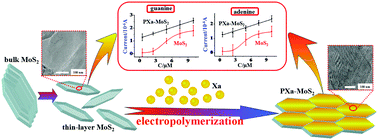Enhanced electropolymerization of poly(xanthurenic acid)–MoS2 film for specific electrocatalytic detection of guanine and adenine†
Abstract
Until now, research studies on the preparation of MoS2-based polymer nanocomposites using the electropolymerization method have been scarce. Herein, for the first time, a poly(xanthurenic acid, Xa) film based on a thin-layer MoS2 support was electrochemically prepared to form a highly electroactive biosensing platform. The thin-layer MoS2 was obtained using a simple ultrasonic method from bulk MoS2. The physical adsorption between MoS2 and aromatic Xa improved the electropolymerization efficiency, accompanied by an increased electrochemical response of PXa. Scanning electron microscopy (SEM), transmission electron microscopy (TEM), cyclic voltammetry (CV), and differential pulse voltammetry (DPV) were utilized to characterize the morphology and investigate the electrochemical properties of the prepared interface. Compared with sole PXa or a MoS2 modified electrode, the PXa–MoS2 hybrid interface exhibited good electrocatalytic activity and prominent synergistic effect on guanine and adenine. A PXa–MoS2 nanocomposite has the negative charge and a specific structure, which obviously prompts the adsorption of the positively charged guanine and adenine. Moreover, this nanocomposite is a promising candidate in electrochemical sensing and other electrocatalytic applications.


 Please wait while we load your content...
Please wait while we load your content...